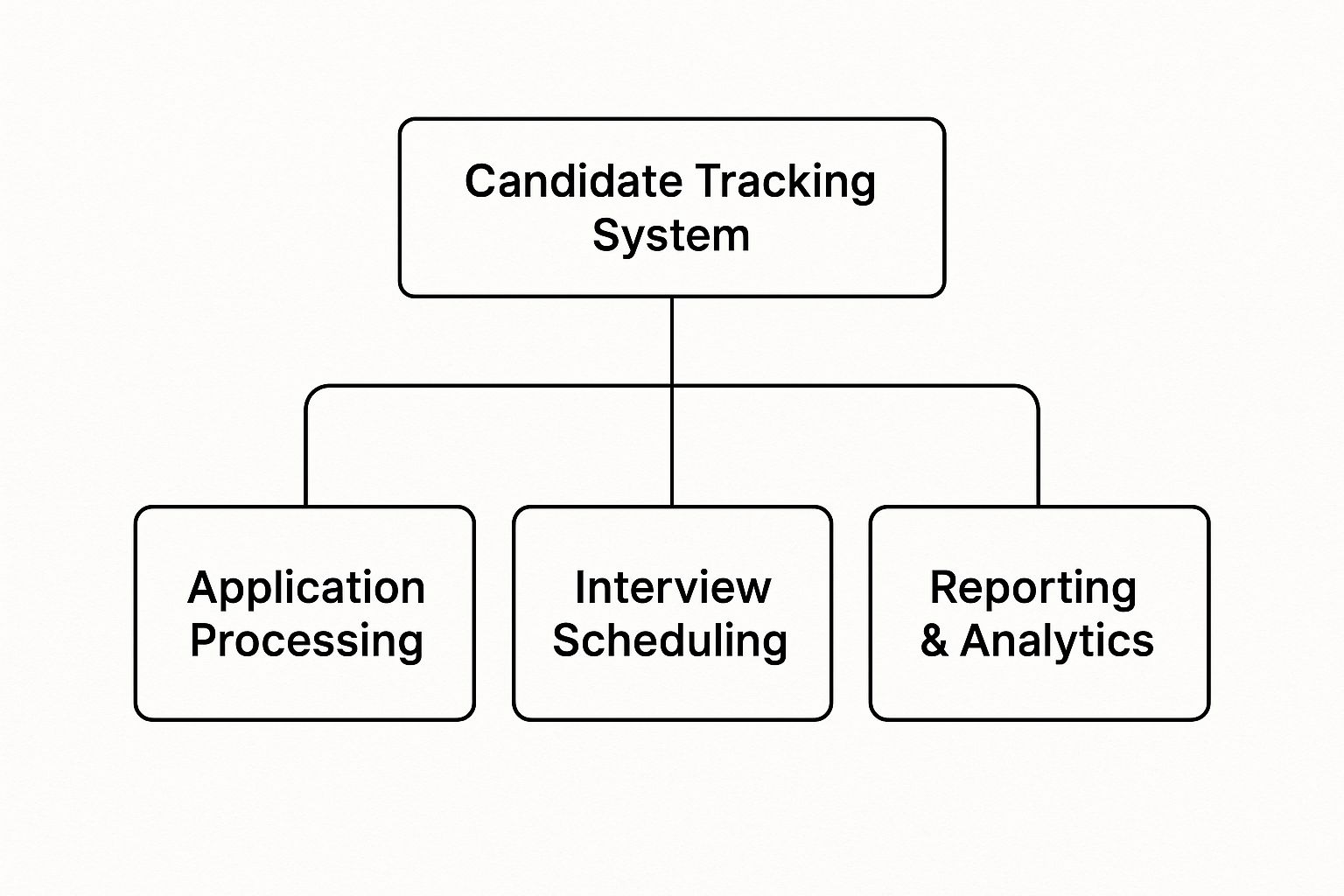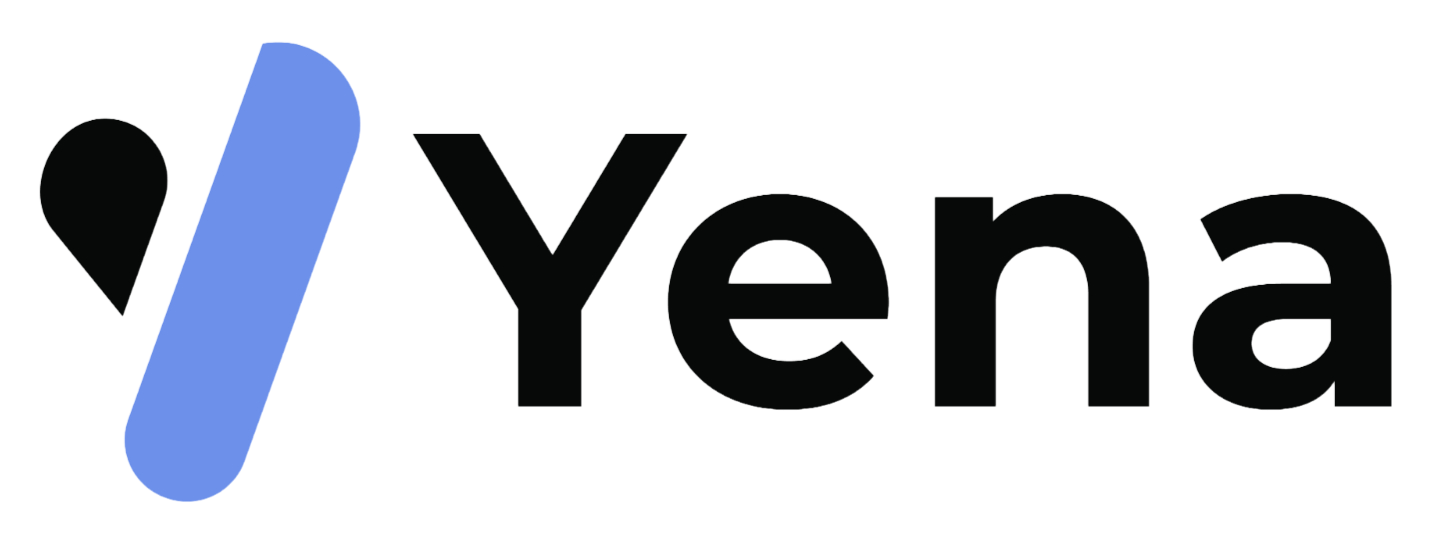Ultimate Guide to Candidate Tracking System for Efficient Hiring
- Janis Kolomenskis
- Jun 18
- 15 min read
Updated: Jun 19
Understanding Candidate Tracking Systems in Plain English

Imagine trying to manage the hiring process for a growing company. Resumes are pouring in from job portals, emails, and referrals, turning your inbox into a chaotic jumble. You're trying to track applicants, interview notes, and team feedback across scattered spreadsheets and sticky notes. It feels like a reactive scramble where great candidates are bound to get lost in the shuffle.
This is the exact problem that a candidate tracking system (CTS) is built to solve. Think of it as your dedicated air traffic control tower for recruitment. It replaces the messy, disconnected methods with a single, organized platform where every application, email, and piece of feedback has a home. It helps turn hiring into a clear, manageable process where each candidate's journey is visible from start to finish.
From Chaos to Cohesion: A Real-World Shift
The difference is stark. Most HR professionals have felt the sting of losing a promising contender in a messy email chain or simply forgetting to follow up. A quality candidate tracking system changes this story entirely. It gives you a structured pipeline, moving applicants from one stage to the next with total clarity. This is about more than just storage; it’s about building a proactive talent pipeline that consistently brings qualified people to your attention for both current and future roles.
This principle of systematically organizing many individual options isn't exclusive to business hiring. For example, Latvia's electoral framework applies a similar logic. Their system lets voters express preferences not just for political parties, but for individual candidates on a party's list. This shows the universal need for structured tracking when you're managing a large number of choices. You can discover more about Latvia's unique electoral approach here.
More Than Just Software: A Strategic Investment
Seeing a candidate tracking system as just an organizational tool misses the bigger picture. The most successful organizations treat it as a strategic investment. Why? Because an efficient process reduces your time-to-hire, helping new team members become productive much sooner. It also allows for better, more transparent teamwork between recruiters and hiring managers, ensuring everyone is aligned on where each candidate stands.
Ultimately, implementing a solid system pays off in several key areas. It supports smarter hiring by giving you data-driven insights, not just gut feelings. This efficiency also drastically improves the candidate experience, as applicants are kept in the loop and feel respected throughout the process. This transforms hiring from a transactional task into a powerful tool for strengthening your employer brand, ensuring even those you don't hire leave with a positive impression.
Essential Features That Separate Great Systems From Average Ones
Not all candidate tracking systems are built the same. A basic system is like a digital filing cabinet; it holds resumes, but you still have to do all the manual sorting and searching. A great system, however, acts more like a dedicated hiring assistant, actively working to take tedious tasks off your plate. The real difference is moving beyond simple storage to features that genuinely speed up your hiring cycle.
These capabilities are what separate a powerful tool from what is essentially a glorified spreadsheet.
The Must-Have Building Blocks
The foundation of any effective candidate tracking system is built on a few non-negotiable features. First up is resume parsing. This is the system's ability to automatically read a resume, pull out key information like contact details, work history, and skills, and use it to build a candidate profile. This one feature eliminates hours of manual data entry and instantly creates a searchable database of talent.
Next is job posting distribution. A strong system lets you write a job description once and then post it to multiple job boards with a single click. This feature alone is a massive time-saver for any recruiting team.
Finally, a customizable workflow pipeline is essential. Think of this as a visual dashboard, often with drag-and-drop cards, that lets you see where every candidate is in your hiring process—from "Applied" to "Interview" to "Hired." This visual clarity ensures no one gets lost in the shuffle.
Advanced Capabilities That Give You a Competitive Edge
While the core features get you organized, advanced capabilities are what create real momentum. Automated communication is a perfect example. A system that can send instant, branded confirmation emails when someone applies or provide updates as they move through stages dramatically improves the candidate experience. Considering how many applicants never hear back from companies, this simple touch of professionalism protects your employer brand.
Collaboration tools are another huge advantage. Instead of messy, disconnected email threads, these features bring the conversation into one place. With internal notes, @mentions to tag hiring managers, and shared scorecards, all feedback is centralized on the candidate's profile. This leads to faster, more informed, and better-aligned decisions.
Perhaps the most powerful feature is reporting and analytics. A top-tier candidate tracking system doesn't just hold your data; it helps you understand it. It can show you which job boards deliver the best applicants, how long it takes to fill a role, and where your bottlenecks are. You can learn more about which essential recruiting metrics to track in our detailed guide. This information is pure gold for refining your entire recruitment strategy.
To better understand how these features stack up, let's compare the basic necessities with the more advanced options that can truly elevate your hiring process.
Essential vs. Advanced Candidate Tracking System Features
Comparison of core features versus premium capabilities in modern candidate tracking systems
Feature Category | Essential Features | Advanced Features | Business Impact |
|---|---|---|---|
Candidate Management | • Resume Parsing• Customizable Pipeline | • Automated Communication• Candidate Scorecards | Frees up administrative time, improves the candidate experience, and ensures consistency in evaluations. |
Sourcing & Outreach | • Job Posting Distribution | • AI-Powered Sourcing• Branded Career Pages | Expands the talent pool beyond active applicants and strengthens your employer brand from the first touchpoint. |
Team & Decision-Making | • Basic User Roles & Permissions | • Collaboration Tools (@mentions, shared feedback)• Interview Scheduling Integration | Centralizes all hiring-related communication, leading to faster, more collaborative, and data-backed decisions. |
Strategy & Improvement | • Basic Candidate Source Tracking | • In-depth Reporting & Analytics (Time-to-Fill, Cost-per-Hire) | Provides the strategic insights needed to identify bottlenecks, optimize spending, and improve the entire hiring process. |
As the table shows, while essential features manage the day-to-day, advanced features provide the intelligence needed to make strategic improvements and gain a real advantage in the hunt for top talent.
The infographic below visualizes the three functional pillars that make up a complete hiring engine.

This illustrates how application processing, interview scheduling, and analytics are not isolated tasks. They are interconnected parts of a system that, when working together, transform your candidate tracking system from a passive database into a dynamic, strategic asset. The ultimate goal is to automate the administrative burden, giving your team the time and insights to focus on what really matters: building relationships and making fantastic hires.
The Real Benefits That Transform Your Hiring Process

Drastically Reduced Time-to-Hire
The first thing you'll notice is a dramatic drop in your time-to-hire. Think about all the administrative tasks that eat up a recruiter's day—sorting through piles of resumes, sending scheduling emails back and forth. A great system automates that grind.
This automation gives your team back their most valuable asset: time. Instead of getting buried in paperwork, they can focus on what really matters—conducting great interviews and building genuine connections with candidates. With automated workflows, some companies see their time-to-hire drop by up to 40%. That means open roles are filled more quickly, minimizing productivity gaps and getting new hires started on making an impact.
Superior Candidate Quality and Experience
A candidate tracking system doesn't just speed things up; it helps you make better choices. With smart filtering and scoring, you can instantly find the best-fit applicants in your talent pool. Your team gets to spend their time talking to high-potential candidates instead of digging through applications that aren't a match. This direct line to quality talent naturally leads to better hires.
At the same time, the system improves the candidate experience. Automated communications keep applicants in the loop, creating a transparent process that builds trust in your employer brand. No one likes applying for a job and hearing nothing back. By keeping everyone informed, even candidates you don't hire can walk away with a positive view of your company, which is priceless in a tight talent market. This thoughtful process prevents anyone from feeling ignored and can even turn applicants into fans.
A Data-Driven Strategic Advantage
Perhaps the most significant long-term gain is moving from guesswork to informed strategy. A system gives you clear reports that show you what's working and what isn't. You can finally answer questions like, "Which job board brings us the best applicants?" or "Where are candidates dropping out of our process?" This clear view lets you constantly fine-tune your approach.
This idea of using data to guide resources is a proven one. For example, in Latvia, public funding for political parties is distributed based on past election results, making sure money flows to where it has been most effective. You can read more about this system of strategic funding. A CTS applies the same logic to your recruiting efforts, helping you invest your time and budget where they will produce the best results.
By turning recruitment data into clear insights, you can build a more effective and resilient hiring machine. These data-backed strategies are key to improving your overall talent acquisition. You can learn how to enhance your talent management system for better results and build a stronger hiring function.
Smart Selection Strategies for Finding Your Perfect Match
Picking a new candidate tracking system is a lot like buying a new car. You can get drawn in by a slick demo and an impressive feature list, but what really matters is how it handles your team's daily commute. A system that seems powerful in a presentation might end up being clunky and slow in real life, creating traffic jams where you need a clear road.
The key to making a great choice is to look past the surface-level shine and focus on how the software will actually function for your team every day.
Map Out Your Recruiting Journey First
Before you schedule a single demo, get your team in a room. Your recruiters, coordinators, and hiring managers are the ones who will be "driving" this system daily, and their insights are invaluable. Without their buy-in, even the best software will just sit in the garage.
Work together to create a list of must-have features versus nice-to-have perks. Ask the tough questions: Where do we get stuck? Is interview scheduling a nightmare of back-and-forth emails? Are we losing great candidates because communication is slow? Are past applicants lost in a digital black hole? Your evaluation checklist should directly address these real-world frustrations. This ensures you're shopping for a solution, not just a collection of new features.
Look Beyond the Shiny Features
With your core needs defined, you can now evaluate potential systems on the criteria that determine long-term success. To avoid buyer's remorse, dig deeper into these key areas:
Scalability: Will this system grow with your company? A tool that's perfect for a team of two might slow to a crawl when you're hiring across ten departments. Ask providers how their system performs with large candidate pools and what their plans are for supporting growing businesses.
User-Friendliness: A system packed with features is worthless if your team finds it too confusing to use. Pay close attention to the user interface during demos. Does it feel intuitive, or does every action require a search through a help manual? Poor adoption due to a confusing design is a massive waste of resources.
Integration Capabilities: Your candidate tracking system needs to be a team player. It must connect seamlessly with the other tools your team relies on, like email, calendars, and your main HR platform. Clunky integrations create disconnected workflows and force your team into mind-numbing manual data entry.
Customer Support and Pricing: Look beyond the sales pitch. Ask for references from current customers to hear about their real experiences with the support team. When it comes to cost, examine the pricing model carefully. Are there hidden fees for adding users, unlocking features, or getting dedicated support? You're looking for a transparent partner, not just a product.
To help organize your thoughts and compare different options objectively, you can use a scorecard. This tool allows you to weigh criteria based on what's most important to your team and score each system accordingly.
Candidate Tracking System Selection Scorecard
Comprehensive evaluation criteria with scoring system for comparing candidate tracking systems
Evaluation Criteria | Weight (1-5) | System A Score (1-10) | System B Score (1-10) | Notes |
|---|---|---|---|---|
User Interface & Ease of Use | 5 | 9 | 6 | Team found A more intuitive. |
Integration with Email & Calendar | 5 | 8 | 8 | Both offer solid integrations. |
Scalability for Future Growth | 4 | 7 | 9 | System B seems better for enterprise. |
Quality of Customer Support | 3 | 9 | 7 | System A has stronger reviews. |
As the scorecard shows, even if one system seems better for future growth (System B), another might win out because of its superior user experience and support (System A), which are weighted more heavily. This method brings clarity to your decision-making process.
Making an informed choice is the first step toward building a more effective and enjoyable hiring process. But the right platform is only half the battle; it must be combined with a smart strategy. To get the most from your new system, check out our guide on the top recruiting best practices to attract talent in 2025. This methodical approach helps you find a long-term partner for your recruiting success.
Implementation Strategies That Guarantee Team Adoption
Think of a powerful candidate tracking system like a high-performance race car. It’s packed with potential, but it’s just an expensive piece of art if your team doesn’t know how to drive it. Many implementations fail not because the software is bad, but because the rollout is treated as a simple IT task instead of what it really is: a fundamental change in how the team works. Successful adoption isn’t about flipping a switch; it’s about building new habits.
Build a Blueprint Before You Build the House
This initial planning stage is where your new system is either set up for success or doomed to become a source of frustration. Before anyone even logs in, your focus should be on data and people. See data migration as a chance for a true fresh start, not just a digital moving day. Decide what candidate information is actually valuable and get rid of the rest. You want to begin with a high-quality talent pool, not a database full of digital clutter.
Next, plan your training with intention. A generic, one-size-fits-all webinar won't cut it. Training must be hands-on and designed for specific roles. What a recruiter needs to master is entirely different from what a hiring manager needs to know. The goal is for everyone to feel capable and confident from their very first click.
Navigating the Human Side of Change
Even the most perfectly planned rollout can hit a wall if you ignore the human element. To get your team genuinely on board, you have to directly address the "but this is how we've always done it" mindset. Start by finding your internal champions—the team members who are genuinely excited about the change. These advocates can become your on-the-ground support system, answering questions and providing honest feedback.
Before going live for everyone, launch a pilot test with a small, engaged group, like a single department. Think of it as a controlled test drive. This gives you a low-risk environment to work out any kinks and fix problems. Success stories from this pilot group will become your most powerful internal marketing tool, showing everyone else what’s possible. Most importantly, communicate the "why." Don’t just explain how to use the new candidate tracking system; show the team how it solves their biggest daily headaches, like less admin work, clearer communication, and no more lost candidates.
Setting the Rules of the Road
Once the system is live, long-term success hinges on consistency. You need to establish clear, simple processes that everyone follows. This discipline creates a single source of truth and stops the team from slowly drifting back to old habits with disconnected emails and spreadsheets. For example:
All interview feedback must be entered as a note in the system within 24 hours.
Candidates must be moved to the next stage in the system as soon as a decision is made.
All communication with candidates should be logged or sent directly from the platform.
This structure is essential. You should also customize the system to mirror your company’s unique hiring stages, making it feel intuitive and built for your team. Finally, define what success looks like and track it. Measure things like user adoption rates and time-to-fill to clearly show the system's value and see where extra support might be needed. True adoption is an ongoing process, not a one-time event.
Advanced Optimization Techniques For Maximum ROI

Once your candidate tracking system is in place, you’re just at the starting line. It’s like buying a gym membership and expecting peak performance—you need a tailored workout plan. Turning this tool into a strategic asset takes deliberate effort: you have to explore every feature and find where the real value hides. This process transforms a simple platform into a high-return investment that reshapes how you attract and hire talent.
From Data To Decisions: Using Analytics
Your analytics dashboard is more than a report—it’s a discovery map. By reviewing it regularly, you shift from reactive hiring to a data-informed strategy. Start by spotting pinch points in your hiring funnel, such as a surge of candidates withdrawing after the first screen. That insight might reveal your job description needs clarity or your early interviews aren’t engaging enough.
This data also helps you refine job ads for higher-quality applicants. A candidate tracking system reveals which channels actually produce successful hires, not just clicks. That information directs your budget toward sources that work. Over time, you can even analyze past hiring cycles to forecast when roles will reopen, giving you a lead on building a talent pipeline.
Automation And Integration With A Human Touch
Optimization isn’t about removing people from the process; it’s about offloading repetitive work so your team can focus on meaningful conversations. Think about automating interview invites by connecting your platform to team calendars—candidates book slots without back-and-forth emails.
The user interface of a modern Applicant Tracking System, another name for a candidate tracking system, often looks something like this:

This pipeline view gives instant visibility into each applicant’s stage and the next action required.
Uncovering Hidden Gems And Creating Feedback Loops
Your existing database is full of potential. Instead of always hunting for new resumes, use advanced filters to rediscover past “silver-medalist” candidates who nearly made the cut. You can also search for unique skill sets in passive profiles you’ve already engaged.
Finally, set up a steady feedback cycle to sharpen your approach:
Build Employer Branding: Highlight metrics like a fast response time on career pages to show you value candidates.
Improve Interviewing: Compare which interview stages produce your strongest hires to refine your questions.
Hold Team Huddles: Meet weekly to review hiring metrics, celebrate wins and address any slowdowns.
This ongoing loop of data review, experimentation and adjustment is where you unlock maximum ROI from your system.
Key Takeaways for Candidate Tracking System Success
True success with a candidate tracking system isn't about getting the one with the most bells and whistles. It’s about making a strategic choice that fits how your team actually works. Think of it less like buying a new piece of software and more like adopting a whole new philosophy for how you find and hire great people. Getting real results comes from a mix of smart selection, careful implementation, and a promise to keep getting better.
To truly upgrade your recruitment process, focus on these core principles that will guide you from your first look at a system to its long-term success.
Your Strategic Action Plan
The journey to finding the right system starts long before you ever see a product demo. A common pitfall is getting dazzled by features before you truly understand the problems you need to solve. A clear action plan ensures you pick a system your team will not only use but actually appreciate.
Define Your Needs First: Before you look at any software, take a hard look at your current hiring process. Where are the roadblocks? Are you losing great applicants because of slow communication? Is scheduling interviews a logistical nightmare? The features you prioritize must be direct solutions to these specific pain points.
Prioritize the User Experience: A system can have all the power in the world, but if it's confusing to use, it will just collect digital dust. When you’re evaluating options, pay close attention to how intuitive the platform feels. If your hiring managers can't easily find profiles and leave feedback, they simply won't use it.
Build Your Implementation Roadmap: Treat the rollout like a major project, not just a quick IT task. You need a plan for migrating your existing data, creating practical, role-based training sessions, and launching a small pilot program to iron out any issues before everyone in the company starts using it.
Measuring What Truly Matters
You can't fix what you can't measure. A modern candidate tracking system gives you the data you need to make decisions based on facts, not just gut feelings. To prove the system is working and delivering a return on your investment, concentrate on a few key performance indicators (KPIs).
Time-to-Hire: This is the classic metric for measuring speed and efficiency. A shorter hiring cycle means you fill open roles faster, which keeps your teams productive and your business growing.
Source of Hire Quality: This helps you understand which channels are delivering the best candidates—the ones who actually get hired and succeed in their roles. This insight allows you to invest your recruitment budget and time far more effectively.
Candidate Satisfaction: Use simple feedback surveys to see what your applicants think of the process. A positive experience builds your employer brand and leaves a good impression, even with candidates who don't get the job.
Building for Long-Term Success
The technology is just one part of the puzzle. Lasting success is all about your people and your processes. Find people within your company who are excited about the new system and can act as champions to encourage their colleagues. Set clear, firm rules for how the system must be used—for example, requiring all interview feedback to be logged within 24 hours—to keep your data clean and reliable.
Keep an eye out for warning signs, like low login rates or teams going back to their old spreadsheets. These are signals that you might need to offer more training or adjust your processes.
Ready to implement a system built for success? Yena's AI-powered platform turns these principles into reality with intuitive workflows and a focus on candidate delight. Discover how Yena can transform your hiring process today.
